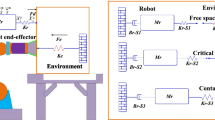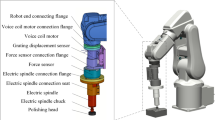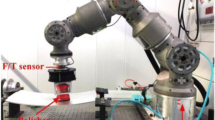Abstract
A contact force tracking method based on variable impedance control was proposed to solve the problem of compliant contact of industrial robots in contact tasks. Firstly, the mathematical model between the contact force steady-state error and the impedance model parameters is analyzed according to the impedance control and second-order environment model. Secondly, the adaptive control rate of robot contact force error and damping parameters are established according to PD controller idea. Finally, the stability of the controller is verified by Routh criterion, and the stability range of the controller parameters is obtained. Experimental results show that compared with impedance control, variable damping impedance control has the characteristics of low overshoot, zero steady-state error, and rapid response, and can follow the dynamic expected force and adapt to the uncertain environment.
Access this chapter
Tax calculation will be finalised at checkout
Purchases are for personal use only
Similar content being viewed by others
References
Merola, M., Ruggiero, A.: On the tribological behavior of retrieved hip femoral heads affected by metallic debris. A comparative investigation by stylus and optical profilometer for a new roughness measurement protocol. Measurement 49(3), 365–371 (2016)
Shoushtari, A.L., Dario, P., Mazzoleni, S.: A review on the evolvement trend of robotic interaction control. Ind. Robot. 43(5), 535–551 (2016)
Rovati, L.P., Zanasi, M.: Design of an optical sensor for surface roughness measurements of wood based panels. In: ISA/IEEE Sensors for Industry Conference, pp. 55–59. IEEE (2004). https://doi.org/10.1109/SFICON.2004.1287129
Tay, C.J., Wang, S.H., Quan, C.: Surface roughness measurement of a semi-conductor wafer using laser scattering technique. In: Gdoutos, E.E. (ed.) Experimental Analysis of Nano and Engineering Materials and Structures, pp. 327–328. Springer, Dordrecht (2007). https://doi.org/10.1007/978-1-4020-6239-1_162
Zhao, G., Zhao, X.Z.: On-line surface roughness measurement based on specular intensity component of speckle patterns. In: IEEE International Conference on Information and Automation, pp. 1050–1055. IEEE (2008). https://doi.org/10.1007/978-1-4020-6239-1_162
Brahmi, B., Laraki, M.H.: Impedance learning control for physical human-robot cooperative interaction. Math. Comput. Simul. 190, 1224–1242 (2021)
Lin, G.R., Shan, B.Q.: Adaptive neural network command filtered backstepping impedance control for uncertain robotic manipulators with disturbance observer. Trans. Inst. Meas. Control. 44(4), 799–808 (2021)
Hogan, N.: Impedance control-an approach to manipulation. I-Theory. II-Implementation. III-Applications. J. Dyn. Syst. Meas. Control-Trans. ASME 107(1), 1–24 (1985)
Jung, S., Hsia, T.C., Bonitz, R.G.: Force tracking impedance control for robot manipulators with an unknown environment: theory simulation and experiment. Int. J. Robot. Res. 20(9), 765–774 (2020)
Erickson, D., Weber, M.: Contact stiffness and damping estimation for robotic systems. Int. J. Robot. Res. 22(1), 41–58 (2003)
Buchli, J., Stulp, F., Theodorou, E., Schaal, S.: Learning variable impedance control. Int. J. Robot. Res. 30(7), 820–833 (2011)
Chao, L.I., Xia, G.H.: Learning variable impedance control based on reinforcement learning control based on reinforcement learning. J. Harbin Eng. Univ. 40(2), 304–311 (2019)
Li, Y., Ge, S.S.: Impedance learning for robots interacting with unknown environments. IEEE Trans. Control Syst. Technol. 22(4), 1422–1432 (2014)
Acknowledgement
This work is supported by the Technical Innovation Major Project of Hubei Province, China under Grant 2020AEA010, and the National Natural Science Foundation of China under Grants 61873248, the Natural Science Foundation of Hubei Province, China under Grant 2020CFA031, and the 111 project under Grant B17040, and the Science and Technology Project of State Grid Corporation of China under Grant 52153216000R.
Author information
Authors and Affiliations
Corresponding author
Editor information
Editors and Affiliations
Rights and permissions
Copyright information
© 2022 The Author(s), under exclusive license to Springer Nature Singapore Pte Ltd.
About this paper
Cite this paper
Gao, X., Chen, X. (2022). Surface Roughness Measurement of Ceramic Products Based on Impedance Control. In: Jia, Y., Zhang, W., Fu, Y., Zhao, S. (eds) Proceedings of 2022 Chinese Intelligent Systems Conference. CISC 2022. Lecture Notes in Electrical Engineering, vol 951. Springer, Singapore. https://doi.org/10.1007/978-981-19-6226-4_38
Download citation
DOI: https://doi.org/10.1007/978-981-19-6226-4_38
Published:
Publisher Name: Springer, Singapore
Print ISBN: 978-981-19-6225-7
Online ISBN: 978-981-19-6226-4
eBook Packages: Computer ScienceComputer Science (R0)




